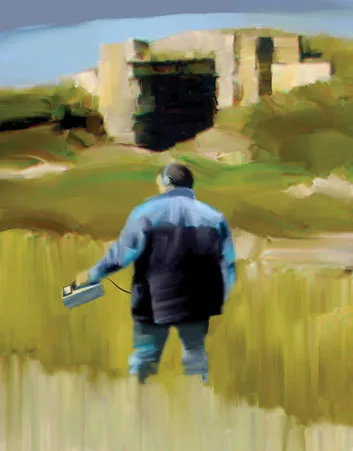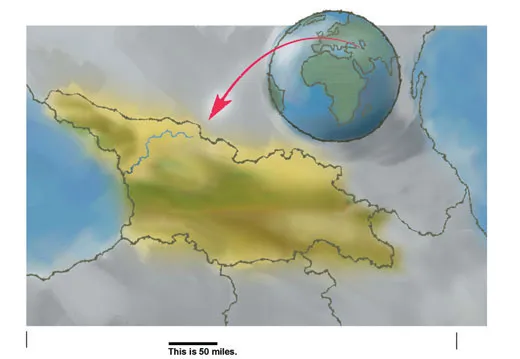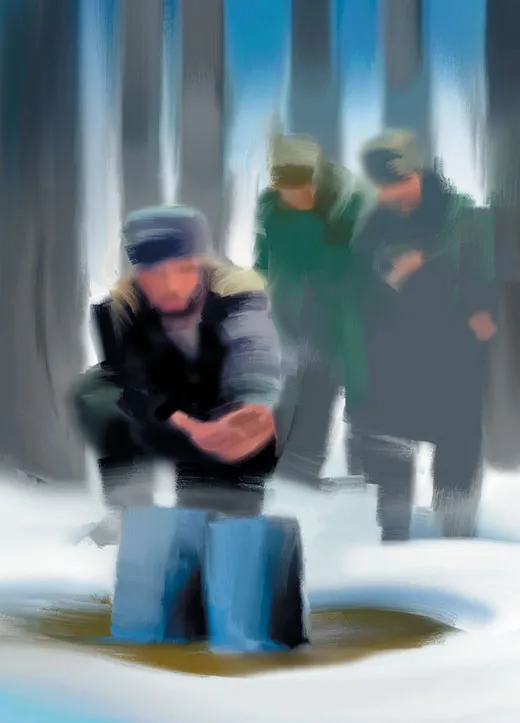The Hunt for Hot Stuff
In the former Soviet Union, “rad rangers” are racing to find lost radiation devices before terrorists can turn them into “dirty bombs”
Lerry Meskhi and I walk into the maw of an artificial hill, one of several missile bunkers on this derelict Soviet military base near Tbilisi, the Republic of Georgia’s capital. As our eyes adjust to the darkness, we follow rusty train tracks into pitch-black catacombs. Using a flashlight and feeling a touch of trepidation, I peer into one of the room-size chambers off the trackway. It’s empty, the warheads, reportedly nuclear missiles once pointed at Turkey, long gone. Still, the old Soviet spirit lingers in yellow Russian signs on the concrete walls. “Operations shall be carried out only on command,” says one. “Do not allow the product to be hit,” says another. But Meskhi, chief of Georgia’s Nuclear and Radiation Safety Service, isn’t interested in Cold War signage. He’s searching for other things the Soviets might have left behind, and he’s hoping to get to them before others do.
He walks out of the dark bunker and into the sunlight, blinking like a mole. A gray-haired, cherub-faced 56-year-old, Meskhi is a local leader of the international effort to hunt down radioactive relics scattered across the frontier of the former USSR. Georgia and other nations, including the United States, are concerned that terrorists could rig stray radioactive materials to conventional explosives to create a “radiation dispersal device,” also known as a dirty bomb.
As far as anyone knows, a dirty bomb has never been detonated. But the Justice Department said last June that U.S. agents had foiled an alleged Al Qaeda plan to obtain materials for a dirty bomb to be set off on U.S. soil. And the BBC reported in late January that British officials have evidence that Al Queda operatives in western Afghanistan had succeeded in building a dirty bomb. At its worst, some experts say, a dirty bomb attack might be comparable to a radiation accident, perhaps like the one in Brazil in 1987, when more than 200 people were exposed—4 fatally—to radioactive cesium 137 from an abandoned radiation therapy machine. Also, U.S. Army medical planners say that a dirty bomb could make victims more susceptible to a subsequent biological or chemical weapon, because exposure to large amounts of ionizing radiation can suppress the immune system.
But assessing the consequences of a detonated dirty bomb is difficult. Some security experts say it would probably not expose many people to a deadly or harmful dose of radioactivity; that is, the injuries would be from the blast itself. Instead, they say, dirty bombs are designed to generate panic, preying on people’s fear of all things radioactive, and to contaminate buildings or neighborhoods, which might have to be decontaminated or razed at great expense. As one journalist put it, a dirty bomb is a weapon not of mass destruction but mass dislocation. A University of Rochester radiation safety expert estimates that more people would be killed in car accidents fleeing a dirty bomb blast in a panic than would be harmed by the unloosed radiation. “We should keep our eye on the ball,” says Matthew Bunn, a nonproliferation expert at HarvardUniversity’s BelferCenter for Science and International Affairs. “Radiological terrorism could be expensive to clean up, but it would not mean tens of thousands of people dead and the heart of a major city incinerated in a flash, as would terrorist use of an actual nuclear weapon.”
Nonetheless, many nations as well as scientific and political organizations view the dirty bomb threat as credible and grave. The International Atomic Energy Agency (IAEA), a United Nations body that serves as the world’s nuclear watchdog, has in recent years dispatched officials and technicians to more than two dozen nations to secure orphaned radiation sources, including abandoned military and agricultural equipment. In Georgia, which has been in the forefront of radiation-hunting by former Soviet states, technicians have scoured urban areas and abandoned military bases—around 15 percent of the country—gathering up some 220 orphaned radioactive objects. Most, like rifle scopes that contain a trace of radium, were trivial; but some, including radioactive generators that nearly killed three civilians, were diabolically hot.
On my trip to Georgia in October, I spent three days with Meskhi and a team of radiation technicians—“rad rangers,” I call them—that searched the countryside and, for the first time, allowed journalists to observe the work. The visit impressed upon me the vast scale of the orphan-radiation problem and the dangers that these ill-paid workers endure to make life a little safer for the rest of us.
Meskhi’s crew—all men—know they’re playing radioactive roulette when they poke into crumbling buildings and wander across rural expanses in pursuit of outdated, perhaps faulty equipment laden with hazardous radioactive compounds. As a hedge against acute radiation illness and possible delayed effects like cancer, each man wears a bright green plastic dosimeter around his neck like a talisman. The device measures cumulative gamma radiation, and when a set limit is reached, a rad ranger’s stint is up. If a team encounters a device that might be potently radioactive, the older workers approach it first, covering it with a lead shield before letting others get close. “When we find big sources, we don’t use young men,” says Giga Basilia of Georgia’s Radiation Service. “They have families to raise.”
As I accompany Basilia and others while they comb the southern perimeter of the Vaziani military base, the crack of gunfire from beyond a nearby hill makes me flinch. Those are practice rounds, Basilia says, from a camp not far away. The U.S. military is training Georgian soldiers reportedly to fight Chechen rebels holed up in the Pankisi Gorge bordering Chechnya. Georgia, which gained independence with the fall of the Soviet Union in 1991, has cultivated close ties with the United States, which is seeking to increase its influence in this impoverished region between the Black Sea and the oil-rich Caspian Sea.
“Look at this!” exclaims one of the rangers, who had wandered over to a pit roughly 30 feet wide, half that in depth, and with perhaps a few feet of stagnant water pooled in the bottom. What catches the eye are two rusting aerial bombs and the bottom segment of some sort of finned rocket, all half-submerged like bathing hippos. The usually gregarious Georgians are at a loss for words. I’m looking suspiciously at gas bubbling up near the bombs when Basilia says, “I have no idea what this is. It’s something unusual. We didn’t know these were here.”
One man—wearing, incongruously, a black Pittsburgh Steelers vest—walks over to the pit and lowers a digital Geiger counter on a strap over the edge. It dangles a few yards over the bombs, which, it turns out, are not nuclear arms. “Sixty-five, sixty-four,” he says, reciting the Geiger counter readout. “Very low.”
The iaea redoubled its efforts to find radioactive junk after a crisis at a former Soviet military base in Georgia nearly six years ago. During the Cold War, the LiloTrainingCenter, also on the outskirts of Tbilisi, prepared troops for the aftermath of a nuclear strike. Soldiers there conducted undisclosed exercises and tests in a mock postapocalyptic environment. Soon after Georgia’s independence, Russia transferred the barracks to the Georgian Army, which used it as a training camp for border guards. Then, beginning in April 1997, several recruits began to suffer intermittent nausea, vomiting and weakness. Lesions the size of silver dollars appeared on their skin. Not until a 20-year-old soldier lost 30 pounds over several months, while at the same time his fingers began shriveling, did physicians diagnose radiation syndrome.
Searching Lilo for the radioactive culprits, scientists working with the Georgian Army turned up scores of them. Among them were a dozen teakettle-size containers of cesium 137, an emitter of gamma radiation, and a capsule of concentrated cesium 137 not much bigger than a Tic Tac, found in a soldier’s jacket pocket. Meskhi says the Soviets had used those items to calibrate radiation monitors, but others say they aren’t sure about that. In any event, all 11 young border guards exposed to the radiation had to undergo painful operations in which large patches of dead skin and flesh were cut away. But they all survived. “This is when we first realized we had a serious problem with orphan [radiation] sources,” says Zurab Tavartkiladze, first deputy minister of Georgia’s Environment Ministry.
Yet another eye-opening radiation accident occurred in Georgia a few years later. On a frigid December afternoon in 2001, three men gathering wood near the InguriRiver in northern Georgia encountered a pair of canisters the size of paint pails. The objects, oddly hot to the touch, had melted surrounding snow. The men settled down for the night by the canisters, as though by a fire. They could not have known that their makeshift heaters were packed with strontium 90, an emitter of beta and gamma radiation.
Within hours they felt nauseated, grew dizzy and started vomiting. Soon their skin started to peel—radiation burn. A stream of beta particles, or electrons, from the strontium had destroyed their skin, while x rays and gamma rays had blasted the underlying tissue. Their wounds festered. Back in Tbilisi, physicians faxed an urgent plea to the IAEA headquarters in Vienna for help securing the devices. “My shock was so great when I learned how radioactive these sources are,” says Abel Julio González, director of radiation and waste safety at the IAEA. The canisters found in Georgia were highly radioactive, on the order of 40,000 curies apiece—about 40 times the output of a radiation therapy machine.
González and colleagues, who immediately realized that the canisters held the makings of a potent dirty bomb, were alarmed by what they later learned about the Soviet-era devices, which powered electrical generators in remote locales and have been largely unknown to Western nuclear authorities until recently. In the generators, high-energy beta particles shed by the strontium 90 slammed into the walls of a titanium-based ceramic receptacle; some energy was shed as x rays and some as heat, warming the ceramic to around 900 degrees Fahrenheit. A transformer converted the heat to electricity. The IAEA says it has captured all six of the strontium 90 generators that it believes were in Georgia, which the Soviets used to power radio transmissions.
But the canisters are turning up all around the old USSR. After being prodded by the IAEA, Russia’s Ministry of Atomic Energy gradually divulged that in Soviet times a factory in Estonia churned out at least 900 of the generators, including some models that are five times more radioactive than the units recovered in Georgia. No more than a couple dozen of the generators have been accounted for, says González, adding that the IAEA’s efforts to track down the missing generators are hampered by a legacy of lost records and even theft. Because the generators once also provided electricity for lighthouses along the Arctic coast, from the Baltic to the Bering Strait, Russia is working with the Norwegian Radiation Protection Authority to salvage radiothermal generators in the Murmansk region and ship them to a Russian nuclear site for storage.
Inspired by the rad rangers’ successes in Georgia, government and IAEA officials are stepping up the search for renegade radiation sources in other former Soviet nations. The United States, Russia and the IAEA teamed up in Moldova last December to capture such materials, and the IAEA sent technicians for the first time into Tajikistan in central Asia. “I used to say that we were seeing the tip of the iceberg,” says González. But in the past year, he says, “more and more of that iceberg has come into the open.”
Still, the most insidious orphaned radioactive source came to light only early last year when the IAEA learned of an experimental agricultural project called Gamma Kolos. (Kolos, a Russian word, refers to grain.) In the Soviet-era program, which started in the 1970s but was abandoned, tractors fitted with containers of cesium 137 (and lead shielding to protect the driver) irradiated wheat seeds before sowing them, in an attempt to induce beneficial mutations in the crops. The radiation was also applied to grain after harvest, to prevent it from germinating. A total of ten of the containers have been recovered in Georgia, Moldova and Ukraine; no one knows how many more are unaccounted for.
To security experts, the scary thing about cesium 137, commonly produced as a powdery cesium chloride compound, is that a terrorist could fill his pockets with it and sprinkle it in a subway car, an office building or a playground and escape notice. “You don’t need a bomb to spread it around,” says González. The terrorist might die from radiation exposure, but that prospect is not necessarily a deterrent. Scores of people could be contaminated, with many becoming seriously ill or dying.
A little-reported accident in Brazil serves as a warning. In September 1987, a young scrap metal scavenger in Goiânia, the capital of Goiás State in the central Brazilian plateau, took a radiation therapy machine from a deserted clinic and sold it to a junk dealer, who wanted the stainless steel. Then the junk dealer noticed a blue glow from a capsule. Someone dug out the powdery material—it was roughly three ounces of cesium 137—with a screwdriver. Others daubed it on their skin as though it were carnival glitter. A 6-year-old girl played with the material, which coated her hands with cesium dust, as she ate.
By the time Goiás authorities brought the situation under control several weeks later, 249 people were found to be contaminated, and the 10 most serious patients were transported to Rio de Janeiro for treatment. The 6-year-old girl was severely ill for a month—dead patches of skin on her hands, hair falling out, capillaries rupturing, infections raging in her lungs and kidneys—before she died.
The accident is not a precise model of what would happen after a dirty bomb exploded, partly because, Bunn says, the victims received very high radiation doses after spreading the cesium on themselves. But, he adds, the high cost of decontaminating the area and the large numbers of worried but unexposed people who showed up at hospitals seeking treatment are possible consequences of a dirty bomb attack.
The incident, classified as one of the worst radiation accidents in history, prompted the IAEA to develop new guidelines for the handling and disposing of radiation sources. The agency is revising those guidelines nowadays in the light of terrorists’ threats and their willingness to sacrifice their own lives in carrying them out. It hopes to aid civil defense planners by describing the terrorist potential of different radiation sources; for instance, even though cesium 137 is no more potent than, say, cobalt 60, it’ll be classified as a more significant terrorist threat because it’s easier to disperse. The IAEA acknowledges that some people may consider the new guidelines too explicit, constituting, as some officials half-jokingly put it, “an Osama bin Laden manual.” But an IAEA official says that it is vital to make such information available so security and health planners can counter the dirty bomb threat. In contrast, the official adds, Al Qaeda “doesn’t need information. It needs opportunity.”
Near the end of my Georgia trip, Tavartkiladze, of the Environment Ministry, agrees to take me to a facility in which the six recovered strontium canisters and four Gamma Kolos containers—among the most dangerous radioactive orphans on earth—are being stored, on the condition I not reveal the facility’s name or location.
Our van pulls onto a dirt road that wends through farmland dotted with livestock and ramshackle barns. Finally, we stop at a padlocked iron gate and Meskhi jumps out to chat with a guard, a gangly young man who does not appear to be armed. He unlocks the gate, and we pass through. A few minutes later, our van parks near a barn-size concrete shed with a steel door. Inside are two, 10-foot-deep concrete chambers; one is covered by a thick concrete lid. The other is open.
We walk on a wooden plank and step onto the concrete lid. In the chamber below are the strontium canisters. “Radiation levels here are at background levels,” Meskhi says, clearly hoping to be reassuring.
In the open chamber are what look like miniature lunar landers. The metal objects, three gray and one white, are about a yard and a half tall and two feet wide; each squats on spindly legs attached to the body by a metal girdle. They are the Gamma Kolos containers, laden with cesium 137. A heavy concrete lid will eventually cover this chamber, too, says Meskhi. I’m pretty sure I’m not in any danger—all that cesium is shielded by the containers’ lead lining—but it’s spinechilling all the same.
As our van rumbles away from this secret site, I feel reasonably assured that the Georgian-IAEA team has rooted out the radiological fugitives in Georgia. But I wonder about other places in the old Soviet empire and about whether the authorities, or terrorists, are rounding up lost or forgotten radiation sources.




